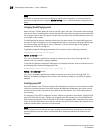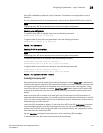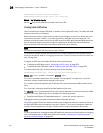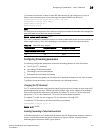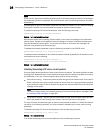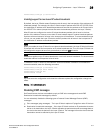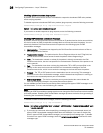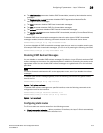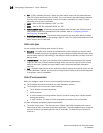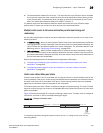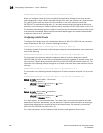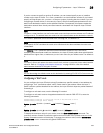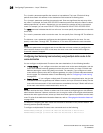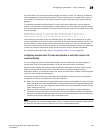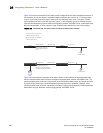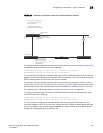
820 PowerConnect B-Series FCX Configuration Guide
53-1002266-01
Configuring IP parameters – Layer 3 Switches
26
• RIP – If RIP is enabled, the Layer 3 Switch can learn about routes from the advertisements
other RIP routers send to the Layer 3 Switch. If the route has a lower administrative distance
than any other routes from different sources to the same destination, the Layer 3 Switch
places the route in the IP route table.
• OSPF – Refer to RIP, but substitute “OSPF” for “RIP”.
• BGP4 – Refer to RIP, but substitute “BGP4” for “RIP”.
• Default network route – A statically configured default route that the Layer 3 Switch uses if
other default routes to the destination are not available. Refer to “Configuring a default
network route” on page 828.
• Statically configured route – You can add routes directly to the route table. When you add a
route to the IP route table, you are creating a static IP route. This section describes how to add
static routes to the IP route table.
Static route types
You can configure the following types of static IP routes:
• Standard – the static route consists of the destination network address and network mask,
and the IP address of the next-hop gateway. You can configure multiple standard static routes
with the same metric for load sharing or with different metrics to provide a primary route and
backup routes.
• Interface-based – the static route consists of the destination network address and network
mask, and the Layer 3 Switch interface through which you want the Layer 3 Switch to send
traffic for the route. Typically, this type of static route is for directly attached destination
networks.
• Null – the static route consists of the destination network address and network mask, and the
“null0” parameter. Typically, the null route is configured as a backup route for discarding traffic
if the primary route is unavailable.
Static IP route parameters
When you configure a static IP route, you must specify the following parameters:
• The IP address and network mask for the route destination network.
• The route path, which can be one of the following:
- The IP address of a next-hop gateway
- An Ethernet port
- A virtual interface (a routing interface used by VLANs for routing Layer 3 protocol traffic
among one another)
- A “null” interface. The Layer 3 Switch drops traffic forwarded to the null interface.
You also can specify the following optional parameters:
• The metric for the route – The value the Layer 3 Switch uses when comparing this route to
other routes in the IP route table to the same destination. The metric applies only to routes that
the Layer 3 Switch has already placed in the IP route table. The default metric for static IP
routes is 1.



